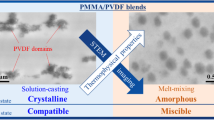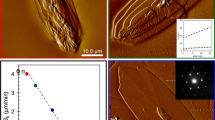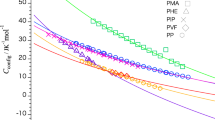Abstract
Two isomeric polyesters, poly(1,6-hexamethylene adipate) (PHA) and poly(ɛ-caprolactone) (PCL), were each blended with amorphous poly(vinyl methyl ether) (PVME) and investigated and compared in the crystalline and amorphous phases. The amorphous phase, Tg, and crystalline morphology of the PVME/PHA blend were compared with those of classical PVME/PCL. Both blend systems exhibit a similar peculiar asymmetry with positive deviation in Tg-composition relationships, and both are similarly miscible, with the PVME/PHA blend exhibiting χ12=−0.21; for PVME/PCL, χ12=−0.20. These values indicate that both blends are similarly miscible but have only quite weak interactions in the amorphous phase. Neat PHA shows a regime-I to -II transition, but neat PCL exhibits a regime-II to -III transition. On blending with PVME (at 20 wt%), both PVME/PCL and PVME/PHA blends undergo changes in crystallization temperature (Tc). Dendritic spherulites in the high-Tc (46 °C or above)-crystallized PVME/PHA blend assume a straight-stalk pattern (chrysanthemum flower pestles or banana stems). In contrast to the similarities in amorphous-phase miscibility, the crystalline phases of these two blends differ significantly. When crystallized at high Tc (46 °C or above), the PVME/PCL (20/80) blend assumes a fluffy feather-like dendritic pattern, which is dramatically different from the straight-stalk dendrites in the PVME/PHA (20/80) blend.
Similar content being viewed by others
Log in or create a free account to read this content
Gain free access to this article, as well as selected content from this journal and more on nature.com
or
References
Yam, W. Y., Ismail, J., Kammer, H. W., Schmidt, H. & Kummerlöwe, C. Polymer blends of poly(ɛ-caprolactone) and poly(vinyl methyl ether)—thermal properties and morphology. Polymer 40, 5545–5552 (1999).
Guo, Q. Completely miscible ternary blends poly(hydroxyether of bisphenal-A)-poly(vinyl methyl ether)-poly(ɛ-caprolactone). Eur. Polym. J. 26, 1329–1332 (1990).
Oudhuis, A.A.C.M., Thiewes, H. J., van Hutten, P. F. & ten Brinke, G A comparison between the morphology of semicrystalline polymer blends of poly(ɛ-caprolactone)/poly(vinyl methyl ether) and poly(ɛ-caprolactone)/(styrene-acrylonitrile). Polymer 35, 3936–3942 (1994).
Bisso, G., Casarino, P. & Pedemonte, E. Thermodynamics of polymer blends based on poly(ɛ-caprolactone)/poly(vinyl methyl ether). Macromol. Chem. Phys. 200, 376–383 (1999).
Chiang, W. J. & Woo, E. M. Comparison of glass transition and interpretation on miscibility in blends of amorphous poly(vinyl methyl ether) with highly crystallizable versus less-crystallizable polyesters. J. Polym. Sci., Polym. Phys. B 45, 2899–2911 (2007).
Brode, G. L. & Koleske, J. V. Lactone polymerization and polymer properties. J. Macromol. Sci. Part A. 6, 1109–1144 (1972).
Wang, J., Cheung, M. K. & Mi, Y. Miscibility and morphology in crystalline/amorphous blends of poly(caprolactone)/poly(4-vinylphenol) as studied by DSC, FTIR, and 13C solid state NMR. Polymer 43, 1357–1364 (2002).
Yen, K. C., Mandal, T. K. & Woo, E. M. Enhancement of bio-compatibility via specific interactions in polyesters modified with a bio-resourceful macromolecular ester containing polyphenol groups. J. Biomed. Mater. Res. Part A 86, 701–712 (2008).
Robeson, L. M., Hale, W. F. & Merriam, C. N. Miscibility of the poly(hydroxy ether) of bisphenol A with water-soluble polyethers. Macromolecules 14, 1644–1650 (1981).
Pedrosa, P., Pomposo, J. A., Calahorra, E. & Cortazar, M. On the glass transition behavior, interaction energies, and hydrogen-bonding strengths of binary poly(p-vinylphenol)/polyether blends. Macromolecules 27, 102–109 (1994).
Chakraborty, S. S., Maiti, N., Mandal, B. M. & Bhattacharyya, S. N. Miscibility and phase diagrams for poly(vinyl methyl ether) and polyacrylate blend systems. Polymer 34, 111–114 (1993).
Mandal, T. K. & Woo, E. M. Marginal miscibility and solvent-dependent phase behavior in solution-blended poly(vinyl methyl ether)/poly(benzyl methacrylate). Macromol. Chem. Phys. 200, 1143–1149 (1999).
Flory, P. J. in Principles of Polymer Chemistry (ed. Flory, P.J.) Ch. XII (Cornell University Press, Ithaca, NY, USA, 1978).
Nishi, T. & Wang, T. T. Melting point depression and kinetic point effects of cooling on crystallization in poly(vinylidene fluoride)-poly(methyl methacrylate) mixtures. Macromolecules 8, 909–915 (1975).
Ahmad, H. & Yaseen, M. in Polymer Handbook (eds Brand, J., Immergut, E.H., Grulke, E.A.) Chap.VII, 706, (Wiley, New York, USA, 1999).
Woo, E. M., Mandal, T. K. & Lee, S. C. Relationships between ringed spherulitic morphology and miscibility in blends of poly(ɛ-caprolactone) with poly(benzyl methacrylate) versus poly(phenyl methacrylate). Colloid. Polym. Sci. 278, 1032–1042 (2000).
Chen, Y. F. & Woo, E. M. Growth regimes and spherulites in thin-film poly(ɛ-caprolactone) with amorphous polymers. Colloid. Polym. Sci. 286, 917–926 (2008).
Hoffman, J. D. Regime III crystallization in melt-crystallized polymers: the variable cluster model of chain folding. Polymer 24, 3–26 (1983).
Acknowledgements
This work was financially supported by a basic research grant (NSC-95 2221 E006 183 and NSC 96-2221-E-006-099-MY3) in consecutive years from National Science Council (NSC) of Taiwan.
Author information
Authors and Affiliations
Corresponding author
Rights and permissions
About this article
Cite this article
Woo, E., Chou, YH., Chiang, WJ. et al. Amorphous phase behavior and crystalline morphology in blends of poly(vinyl methyl ether) with isomeric polyesters: poly(hexamethylene adipate) and poly(ɛ-caprolactone). Polym J 42, 391–400 (2010). https://doi.org/10.1038/pj.2010.18
Received:
Revised:
Accepted:
Published:
Issue date:
DOI: https://doi.org/10.1038/pj.2010.18
Keywords
This article is cited by
-
PEO/PEG-b-P(MA-POSS)/LiClO4 blend solid polymer electrolyte for enhanced lithium-ion conductivity: fabrication, characterization, and electrochemical impedance spectroscopy
Journal of Materials Science (2023)
-
Novel miscible blends of biodegradable polymer and biocompatible polyphenol acquired from natural source
Journal of Polymer Research (2013)



